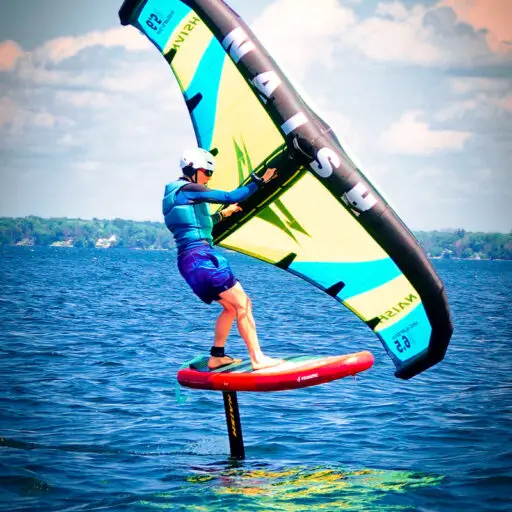Support our hydrofoil educational content for free when you purchase through links on our site. Learn more
What is a Hydrofoil? 10 Fascinating Facts You Need to Know! 🌊 [2025]

Have you ever wondered what it feels like to fly over water? Hydrofoiling offers that exhilarating experience, transforming the way we interact with the waves. This innovative technology uses a wing-like structure to lift riders above the water’s surface, creating a smooth and efficient ride that feels almost magical. In this article, we’ll explore 10 fascinating facts about hydrofoils that will not only pique your interest but also enhance your understanding of this thrilling sport.
Did you know that hydrofoils can reduce drag by up to 60% compared to traditional boards? This efficiency allows riders to reach impressive speeds with less effort, making it a game-changer in the world of watersports. Whether you’re a seasoned pro or a curious beginner, this guide will equip you with everything you need to know about hydrofoiling, from its mechanics to safety tips and the best gear to get started.
Key Takeaways
- Hydrofoils lift riders above the water, providing a smooth and efficient ride.
- The technology is based on principles of lift, similar to airplane wings, allowing for reduced drag and increased speed.
- Hydrofoiling can be applied across various watersports, including surfing, kiteboarding, and sailing.
- Safety gear is essential for hydrofoiling, including helmets and impact vests.
- Modern hydrofoil designs are becoming more accessible and affordable, making it easier for newcomers to join the fun.
Ready to take the plunge? 👉 Shop Hydrofoil Gear:
- Lift Foils: Amazon | Lift Foils Official Website
- GoFoil: Amazon | GoFoil Official Website
- Slingshot: Amazon | Slingshot Official Website
Dive into the world of hydrofoiling and experience the thrill of flying over water! 🏄♂️✨
Table of Contents
Quick Tips and Facts
What is Hydrofoiling? A Deep Dive into Foil Technology
The Science Behind Hydrofoils: Hydrodynamic Mechanics Explained
The Evolution of Hydrofoiling: A Historical Perspective
Hydrofoils in Military Applications: A Look at Innovation
Hydrofoiling in Sailing and Sports: Transforming Water Sports
Modern Passenger Boats: The Future of Hydrofoil Technology
Top Hydrofoil Brands and Their Innovations
Hydrofoiling Safety Tips: Staying Safe on the Water
Environmental Impact of Hydrofoils: A Sustainable Perspective
Future Trends in Hydrofoiling: What’s Next?
Conclusion
Recommended Links
FAQ
Reference Links
Quick Tips and Facts
- Hydrofoiling is like flying on water! The feeling is often described as a mix between surfing, snowboarding, and flying. 🤯
- You don’t need huge waves to hydrofoil. Even small waves or calm water can be enough to get you going.
- Hydrofoils are incredibly efficient, allowing for high speeds and long rides with minimal effort. 🚀
- Safety first! Always wear a helmet and consider other protective gear like impact vests and leg leashes.
- Learning to hydrofoil takes time and practice. Don’t get discouraged if you don’t get it right away.
What is Hydrofoiling? A Deep Dive into Foil Technology
Have you ever dreamt of flying over water? Hydrofoiling turns that dream into reality! It’s a rapidly growing watersport that uses a wing-like device called a hydrofoil, attached to a board, to lift the rider above the surface of the water. As the board gains speed, the hydrofoil generates lift, elevating you above the chop and creating a feeling of effortless gliding.
Master Hydrofoiling: 10 Essential Tips for Thrilling Rides! 🏄♂️ 2025
How Hydrofoils Work: Physics in Action
Remember the feeling of an airplane taking off? Hydrofoils operate on the same principle of lift, but instead of air, they use water. Here’s a breakdown:
- The Foil: The hydrofoil is shaped like an airplane wing, with a curved upper surface and a flatter underside.
- Water Flow: As the board moves through the water, the shape of the foil forces water to flow faster over the top surface than the bottom.
- Pressure Difference: This difference in water speed creates a pressure difference – lower pressure on the top and higher pressure on the bottom.
- Lift: The higher pressure underneath the foil pushes upward, generating lift. This lift force counteracts gravity, raising the board and rider out of the water.
Why Hydrofoiling is Making Waves:
- Smooth Operator: Say goodbye to bumpy rides! Hydrofoils rise above the surface, gliding over chop and delivering a buttery-smooth experience.
- Efficiency is King: Hydrofoils drastically reduce drag, allowing you to reach impressive speeds with less effort. This means longer rides, more fun, and less fatigue.
- Versatility: From surfing to kiteboarding to simply cruising, hydrofoils can be adapted to a variety of watersports, adding a whole new dimension to your experience.
The Science Behind Hydrofoils: Hydrodynamic Mechanics Explained
Ready to geek out a bit? Let’s dive deeper into the fascinating world of hydrodynamics and understand the forces at play when you’re hydrofoiling.
Bernoulli’s Principle: The Key to Lift
At the heart of hydrofoiling lies Bernoulli’s Principle, a fundamental concept in fluid dynamics. This principle states that as the speed of a fluid (in our case, water) increases, its pressure decreases.
Remember the curved shape of the hydrofoil? This design is crucial in creating the pressure difference needed for lift. As water flows over the curved upper surface, it accelerates, leading to a decrease in pressure. Meanwhile, the water flowing underneath the foil maintains a relatively slower speed and higher pressure. This pressure difference generates an upward force – lift – that pushes the foil (and you!) upwards.
Angle of Attack: Fine-Tuning the Ride
The angle at which the hydrofoil meets the water, known as the angle of attack, plays a critical role in determining the amount of lift generated.
- Higher Angle: A steeper angle of attack creates more lift, allowing for quicker takeoffs and slower speeds. However, it also increases drag.
- Lower Angle: A shallower angle of attack reduces drag, enabling higher speeds. However, it requires more speed to generate enough lift to get you up on the foil.
Experienced hydrofoilers masterfully adjust their weight distribution and body positioning to control the angle of attack, optimizing their ride for speed or maneuverability.
The Evolution of Hydrofoiling: A Historical Perspective
Hydrofoiling might seem like a modern marvel, but its roots stretch back over a century! Let’s take a trip down memory lane and explore the fascinating history of hydrofoil technology.
Early Innovations: From Dreams to Reality
- 1869: Frenchman Emmanuel Denis Farcot patents a system of inclined planes designed to lift vessels out of the water.
- Late 19th Century: Italian inventor Enrico Forlanini conducts pioneering experiments with hydrofoils, developing a “ladder” foil system.
- Early 20th Century: British engineer John Thornycroft achieves groundbreaking speeds with his hydrofoil boat, the Miranda III.
Mid-20th Century: The Rise of Passenger Hydrofoils
- 1950s: Swiss company Supramar revolutionizes water transportation with the launch of the PT10 “Freccia d’Oro,” the first commercial hydrofoil passenger ferry.
- 1950s-1970s: Supramar’s designs, including the iconic PT20 and PT50, gain popularity worldwide, with hundreds of hydrofoils built by companies like Rodriquez.
- Soviet Era: The Soviet Union embraces hydrofoil technology, developing high-speed passenger ferries like the Raketa, Meteor, and Voskhod, many of which are still in operation today.
Modern Era: From Military to Mainstream
- Late 20th Century: Hydrofoils find applications in military vessels, with countries like Canada, the USSR, and the US exploring their potential for speed and maneuverability.
- 21st Century: Hydrofoiling experiences a resurgence in the world of watersports, with innovations in design and materials making it more accessible and exciting than ever.
Hydrofoils in Military Applications: A Look at Innovation
While hydrofoils are best known for their recreational and commercial uses, they’ve also played a significant role in military history. Let’s explore how these speedsters have been deployed in naval operations.
Speed and Agility: A Tactical Advantage
Hydrofoils offer a unique combination of speed and agility, making them attractive for various military applications:
- Fast Attack Craft: Their ability to reach high speeds makes them ideal for quick strikes and rapid response.
- Patrol Boats: Hydrofoils can cover large areas quickly, making them effective for patrolling coastlines and waterways.
- Mine Countermeasures: Their shallow draft allows them to operate in areas where traditional vessels might struggle, making them suitable for minehunting and minesweeping operations.
Notable Military Hydrofoils:
- HMCS Bras d’Or (Canada): This experimental hydrofoil, launched in 1968, achieved an impressive speed of 63 knots (117 km/h) but was later canceled due to budget cuts.
- Pegasus class (US Navy): These hydrofoils, in service from 1977 to 1993, were used for patrol and anti-surface warfare.
- Sparviero class (Italian Navy): Armed with a 76 mm gun and missiles, these fast attack craft could reach speeds of up to 50 knots (93 km/h).
Challenges and Limitations:
While hydrofoils offer advantages in speed and agility, they also come with challenges:
- Complexity: Hydrofoil systems are complex and require specialized maintenance, making them more expensive to operate than traditional vessels.
- Sea Conditions: Rough seas can significantly impact their performance and stability.
- Vulnerability: Their small size and lightweight construction can make them more vulnerable to enemy fire.
Hydrofoiling in Sailing and Sports: Transforming Water Sports
Hold on tight! Hydrofoiling has taken the world of sailing and watersports by storm, injecting a dose of adrenaline and innovation into traditional disciplines.
Sailing on Stilts: The Foil Revolution
Imagine a sailboat literally flying over the water! That’s the magic of hydrofoiling in sailing. Foiling sailboats, equipped with hydrofoils attached to their hulls, rise above the surface as they gain speed, significantly reducing drag and unlocking incredible performance.
- America’s Cup: This prestigious sailing competition has embraced foiling technology in recent editions, with boats reaching breathtaking speeds and captivating audiences worldwide.
- Speed Records: Hydrofoiling sailboats have shattered speed records, pushing the boundaries of what’s possible on water. The Hydroptère and Vestas Sailrocket are prime examples of these engineering marvels.
Hydrofoiling for Everyone: A Sport for All Levels
What was once a niche technology is now accessible to watersport enthusiasts of all levels:
- Kitefoiling: Combining the thrill of kiteboarding with the efficiency of hydrofoils, kitefoiling allows riders to harness the wind’s power to soar across the water.
- Windfoiling: Similar to kitefoiling but using a handheld sail, windfoiling offers a more accessible entry point into the world of foiling.
- Wing Foiling: This rapidly growing sport uses a handheld inflatable wing to propel riders on a hydrofoil board, providing a unique blend of surfing, windsurfing, and foiling sensations.
Beyond the Board: Other Hydrofoil Applications
The versatility of hydrofoils extends beyond traditional boards:
- Hydrofoil Kayaks: These kayaks feature retractable hydrofoils, allowing paddlers to switch between traditional paddling and foiling for an added dimension of fun.
- Hydrofoil E-bikes: Yes, you read that right! Electric hydrofoil bikes, like the Manta5 Hydrofoiler XE-1, combine cycling with the thrill of flying over water.
Modern Passenger Boats: The Future of Hydrofoil Technology
Remember those sleek and futuristic-looking boats you’ve seen gliding effortlessly across the water? Those are likely hydrofoil passenger boats, making a comeback as a sustainable and efficient mode of transportation.
A Resurgence in Popularity:
Hydrofoil passenger boats are experiencing a resurgence in popularity, driven by several factors:
- Fuel Efficiency: As concerns about climate change and fuel costs rise, hydrofoils offer a more sustainable alternative to traditional passenger vessels.
- Speed and Comfort: Their ability to bypass surface waves provides a smoother and faster ride for passengers.
- Technological Advancements: Modern hydrofoil designs incorporate advanced materials and control systems, improving their performance, stability, and comfort.
Leading the Way: Companies and Innovations
- Voskhod: The iconic Soviet-era Voskhod hydrofoils are still in operation in various parts of the world, with updated models like the Voskhod-2M FFF (Eurofoil) offering modern amenities and improved efficiency.
- Kometa: Russia is reviving its hydrofoil industry, with companies like Vympel producing new models like the Kometa 120M for passenger transport.
- Boeing 929: These jet-powered hydrofoils, known for their speed and comfort, are widely used in Asia for passenger services, particularly between Hong Kong and Macau.
A Sustainable Future:
Hydrofoil passenger boats offer a promising solution for sustainable and efficient water transportation. As technology continues to advance and the demand for eco-friendly options grows, we can expect to see more of these futuristic vessels gracing our waterways.
Top Hydrofoil Brands and Their Innovations
Choosing the right hydrofoil gear can make all the difference in your foiling journey. With so many brands and models on the market, it’s essential to know what sets them apart. Let’s explore some of the top hydrofoil brands and their innovative offerings:
Lift Foils:
- Known for: High-performance foils, innovative designs, and a focus on modularity.
- Key Products: A wide range of foils for various disciplines, including surfing, kiteboarding, and wing foiling.
- Innovations: Pioneered the use of carbon fiber in hydrofoils, resulting in lighter and more responsive designs.
👉 CHECK PRICE on: Amazon | Lift Foils Official Website
GoFoil:
- Known for: User-friendly foils, durable construction, and a focus on accessibility.
- Key Products: Foils for beginners and experienced riders, with a focus on stability and ease of use.
- Innovations: Developed the “Maliko” foil, specifically designed for downwind foiling, offering exceptional glide and stability.
👉 CHECK PRICE on: Amazon | GoFoil Official Website
Slingshot:
- Known for: High-quality watersports equipment, innovative designs, and a reputation for performance.
- Key Products: A comprehensive range of hydrofoils, boards, and accessories for various foiling disciplines.
- Innovations: Introduced the “Hover Glide” foil system, known for its smooth ride and effortless lift.
👉 CHECK PRICE on: Amazon | Slingshot Official Website
F-One:
- Known for: Cutting-edge designs, high-performance foils, and a strong presence in the kitefoiling world.
- Key Products: Foils, boards, and kites designed for speed, maneuverability, and performance.
- Innovations: Developed the “Diablo” kite, specifically designed for foiling, offering exceptional lift and control.
👉 CHECK PRICE on: Amazon | F-One Official Website
Naish:
- Known for: A legacy of innovation in watersports, high-quality products, and a commitment to performance.
- Key Products: A wide range of hydrofoils, boards, and accessories for surfing, kiteboarding, and wing foiling.
- Innovations: Introduced the “Jet” foil system, known for its speed, stability, and versatility.
👉 CHECK PRICE on: Amazon | Naish Official Website
Hydrofoiling Safety Tips: Staying Safe on the Water
Hydrofoiling is an exhilarating sport, but it’s essential to prioritize safety. Here are some crucial tips to keep in mind:
Gear Up for Safety:
- Helmet: A must-have to protect your head from impacts.
- Impact Vest: Provides buoyancy and impact protection.
- Leg Leash: Prevents the board from shooting away from you in case of a fall.
- Protective Gear: Consider wearing gloves, knee pads, and shin guards for added protection.
Choose Your Location Wisely:
- Open Water: Opt for areas free from obstacles like boats, swimmers, and shallow reefs.
- Wind and Water Conditions: Start with calm conditions and gradually progress to stronger winds and waves.
- Buddy System: Always foil with a partner for added safety.
Master the Basics:
- Lessons: Consider taking lessons from a certified instructor to learn proper techniques and safety procedures.
- Start Slow: Begin with short rides and gradually increase your speed and distance as you gain confidence.
- Respect Your Limits: Don’t push yourself beyond your skill level.
Be Aware of Your Surroundings:
- Other Water Users: Be mindful of boats, swimmers, and other watercraft.
- Water Depth: Be aware of shallow areas and submerged obstacles.
- Weather Changes: Keep an eye on the weather and be prepared for sudden changes.
Environmental Impact of Hydrofoils: A Sustainable Perspective
As with any watersport, it’s crucial to consider the environmental impact of hydrofoiling. Let’s explore the sustainability aspects of this thrilling activity:
Positive Impacts:
- Low Emissions: Hydrofoils are incredibly efficient, requiring minimal energy to propel them. This translates to lower emissions compared to motorized watersports.
- Minimal Wake: Their design generates minimal wake, reducing disturbance to marine life and shorelines.
- Quiet Operation: Hydrofoils operate quietly, minimizing noise pollution in aquatic environments.
Potential Concerns:
- Materials and Manufacturing: The production of hydrofoils, like any manufactured product, involves resource extraction and carbon emissions.
- Collisions with Marine Life: While the risk is relatively low, there’s a potential for hydrofoils to collide with marine animals, particularly in areas with high marine traffic.
Minimizing Your Footprint:
- Choose Sustainable Brands: Support companies that prioritize eco-friendly materials and manufacturing processes.
- Proper Disposal: Dispose of old foils and equipment responsibly through recycling programs or appropriate waste management facilities.
- Respect Wildlife: Be mindful of marine life and maintain a safe distance to avoid disturbances.
Future Trends in Hydrofoiling: What’s Next?
The world of hydrofoiling is constantly evolving, with new innovations and trends emerging all the time. Here’s a glimpse into the exciting future of this dynamic sport:
Technological Advancements:
- Smarter Foils: Expect to see foils with integrated sensors and smart technology, providing riders with real-time performance data and enhancing safety.
- Advanced Materials: The use of lighter and stronger materials, such as graphene and advanced composites, will lead to even more efficient and responsive hydrofoils.
- Electric Hydrofoils: Electric hydrofoil boards, already gaining popularity, will become more powerful, efficient, and affordable, offering a sustainable alternative to gas-powered watersports.
Expanding Horizons:
- New Disciplines: Hydrofoiling will continue to branch out into new disciplines, with innovations in board design and foil technology opening up new possibilities for riders.
- Increased Accessibility: As the sport grows, expect to see more affordable hydrofoil options, making it accessible to a wider range of enthusiasts.
- Growing Communities: Hydrofoiling communities will continue to thrive online and offline, connecting riders, sharing knowledge, and fostering the growth of the sport.
Conclusion

Hydrofoiling is not just a sport; it’s an exhilarating experience that combines the thrill of flying with the joy of gliding over water. From its fascinating history to its modern applications in both recreational and military contexts, hydrofoiling has proven to be a game-changer in the world of watersports. Whether you’re a seasoned pro or a curious beginner, there’s a place for you in the hydrofoiling community.
Summary of Positives and Negatives
Positives:
- Smooth Ride: Hydrofoils provide a buttery-smooth experience, gliding over choppy waters effortlessly. 🌊
- Efficiency: They reduce drag significantly, allowing for high speeds with less energy.
- Versatility: Hydrofoils can be used in various watersports, from surfing to kiteboarding to sailing.
Negatives:
- Learning Curve: Hydrofoiling requires practice and balance, which can be challenging for beginners.
- Safety Concerns: The sharp blades can pose risks, making safety gear essential.
- Cost: Quality hydrofoil equipment can be an investment.
In summary, if you’re looking for a thrilling way to explore the water while enjoying the sensation of flight, hydrofoiling is definitely worth trying! So grab your gear, hit the water, and experience the magic of hydrofoiling for yourself! 🏄♀️
Recommended Links
👉 Shop Hydrofoil Gear:
- Lift Foils: Amazon | Lift Foils Official Website
- GoFoil: Amazon | GoFoil Official Website
- Slingshot: Amazon | Slingshot Official Website
- F-One: Amazon | F-One Official Website
- Naish: Amazon | Naish Official Website
Books on Hydrofoiling:
FAQ

What are the advantages of using a hydrofoil?
Hydrofoils offer several advantages:
- Reduced Drag: By lifting the hull out of the water, hydrofoils minimize drag, allowing for faster speeds and more efficient rides.
- Smooth Ride: They glide over choppy water, providing a more comfortable experience compared to traditional boards.
- Versatility: Hydrofoils can be used in various water sports, making them suitable for a wide range of enthusiasts.
Read more about “How Does a Hydrofoil Work on an Outboard Motor? 7 Key Insights 🚤 …”
How does a hydrofoil work under the water?
Hydrofoils operate on the principle of lift, similar to airplane wings. As the hydrofoil moves through the water:
- The shape of the foil creates a pressure difference between the top and bottom surfaces.
- Water flows faster over the curved top surface, reducing pressure, while the slower-moving water underneath creates higher pressure.
- This pressure difference generates lift, raising the board and rider above the water.
Read more about “How to Install a Hydrofoil on a Boat: 8 Essential Steps 🚤 …”
What types of hydrofoils are used in different water sports?
There are several types of hydrofoils designed for various water sports:
- Surf Foils: Typically shorter and designed for wave riding.
- Kite Foils: Built for stability and performance in kiteboarding.
- Wake Foils: Designed for use behind boats, offering a balance of lift and control.
- Wind Foils: Tailored for windsurfing, allowing for efficient sailing.
Read more about “Master Hydrofoiling: 10 Essential Tips for Thrilling Rides! 🌊 …”
How do I learn to ride a hydrofoil board?
Learning to ride a hydrofoil board involves:
- Start with a Lesson: Consider taking lessons from a certified instructor to learn proper techniques.
- Begin on a Wake Foil: Start by practicing behind a boat to get comfortable with the balance and control.
- Practice Weight Distribution: Learn to shift your weight to control the angle of attack and maintain stability.
- Be Patient: Expect falls and practice regularly to build confidence and skill.
Read more about “What is the Best Speed for Hydrofoiling Behind a Boat? 🚤”
What safety precautions should I take when hydrofoiling?
Safety is paramount in hydrofoiling. Here are some precautions:
- Wear Protective Gear: Always wear a helmet, impact vest, and consider leg leashes.
- Choose Safe Locations: Opt for open water away from obstacles and other water users.
- Start Slow: Begin in calm conditions and gradually progress to more challenging environments.
- Stay Aware: Be mindful of your surroundings and respect marine life.
Read more about “🚀 10 Best Hydrofoils for Sale in 2025: Ride the Waves Like Never Before!”
What are the best conditions for hydrofoiling?
The best conditions for hydrofoiling include:
- Light Winds: Calm to moderate winds provide a stable environment for beginners.
- Flat Water: Smooth water surfaces reduce the risk of jarring impacts and make it easier to learn.
- Good Visibility: Clear conditions help you stay aware of your surroundings and avoid hazards.
Read more about “How Easy is Hydrofoiling? 10 Essential Tips for Beginners 🌊 …”
Reference Links
Explore the world of hydrofoiling and discover the thrill of flying over water! 🌊✨

